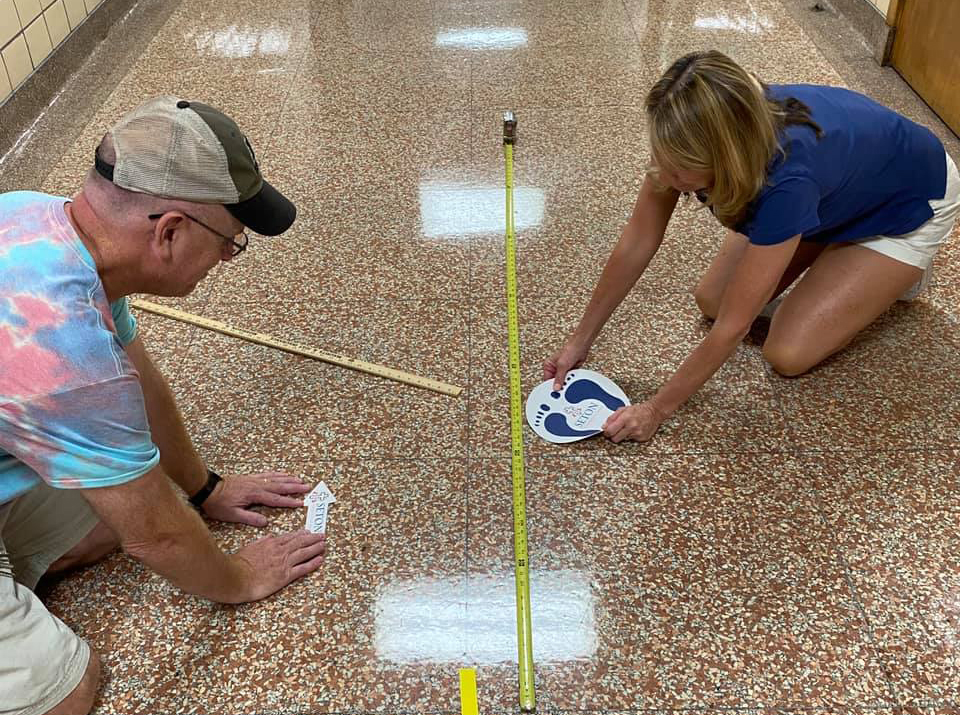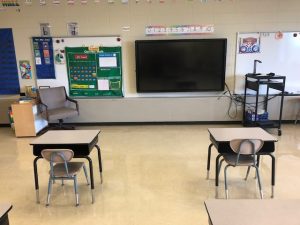Flexibility, creativity are key as schools around the Diocese of Peoria reopen

Jane Barrett, principal at Seton Catholic School in Moline, and "Mr. Tony" Kerker, maintenance, measure out spaces on the hallway floor to give returning students some idea of what safe social distancing looks like. It is a scene being repeated at the 42 Catholic schools around the diocese as classes resume. (Provided photo)
“Flexibility” remains the key word as Catholic schools around the Diocese of Peoria have started to reopen for the 2020-2021 academic year. Joining them are Catholic school students from around the state, with all six dioceses making in-class instruction, as well as remote learning, available.
Coming in as a close second to “flexibility” is the word “creativity” as principals, teachers and staffs try to make things as stress-free as possible for families so students of all ages get the most out of every instructional minute. In the Quad Cities, that means Alleman High School and Jordan Catholic School in Rock Island, Seton Catholic School in Moline, and Our Lady of Grace Catholic Academy in East Moline coordinated their schedules.
“One goal for the four administrators working together is to collaborate and try to be unified for our families and for each other and be a source of support for each other,” said Sara Stroud, principal at Alleman. “We tried to have our release time coincide with their release times as much as we can.”
“We need to make sure we help our parents,” said Jacob Smithers, principal at Jordan. “The last thing we need to do is make it harder for them — life is hard enough for them right now.”
Each school will be open for in-person learning five days a week in the morning. The dismissal at or around lunch time in each school will allow the high school students to pick up their younger brothers and sisters. Grab-and-go lunches will be available.
—
RELATED STORY: Three area physicians share perspective on reopening schools in new video
GROWING IN FAITH
At Alleman, students will have seven 30-minute classes that will allow for direct instruction in each subject.
“That also gives students, especially in our math and physics and science classes, some opportunity for in-person questions,” Stroud explained. “Any independent assignments will be done at home in the afternoon.”
“There’s something greater than COVID here. . . . It’s the hope and life of Jesus Christ. We celebrate that best in community.” Father Matthew Hoelscher, chaplain, Alleman High School, Rock Island
The four-minute passing periods will be staggered so everyone isn’t in the hall at once, she said. In addition, the four grade levels will occupy different areas of the building in an effort to minimize the opportunity for students to cross paths.
In the afternoon, the teachers will have at least two hours to get in touch with those who have chosen remote learning.
In planning for the new year, the focus was on making it possible for the students to pray together every day so they could continue to grow in their faith and relationship with God, Stroud said.
“I think our number one goal was acknowledging that Christ became man and he encounters us in a personal, physical way. He called the Twelve to be a community,” said Father Matthew Hoelscher, chaplain. “The human person thrives when we’re in relationship and in community.”
Coming together again is vital, he said. “Our students need that, our faculty needs that, we need that.”
Since they won’t be able to gather as a school community for Mass at this time, Father Hoelscher will celebrate Mass during a different theology class every day. Not only will that make social distancing possible, but it will give him time to clean and purify the chapel, he said.
“I think I’d be really depressed if I thought all of this was simply to communicate facts,” Father Hoelscher told The Catholic Post. “There’s something greater than COVID here. . . . It’s the hope and life of Jesus Christ. We celebrate that best in community.”
“IT WILL BECOME SECOND NATURE”
On the elementary level, religion will also be among the core subjects taught during the four-hour morning session, according to Smithers and Jane Barrett, principal at Seton. The others are math, English language arts, science and social studies.
The “specials” — music, PE and art — will be done at home with lessons provided for the families or added gradually.

Safely distanced desks in the first grade classroom at St. Malachy School in Geneseo. (Provided photo)
Classes will be kept together as much as possible, which isn’t unusual for the younger grades, the principals said. The adjustment will come for the middle school students who will stay in their classrooms while the teachers change.
Barrett said she’s trying to manage expectations for students and teachers, because they aren’t returning to a school setting they’re used to. With masks and social distancing, “it’s going to be a very different world.”
For virtual learners, there will be opportunities to log in for live instruction with their classmates and a dedicated time in the afternoon to communicate with their teachers and ask questions.
“We’re trying to take everything very slowly,” Barrett said. “Let’s get the kids back in. Let’s get settled. Let’s get started on what and where these kids are academically and then slowly add things in instead of trying to pile everything on at once. . . . I think in a couple weeks this will probably become second nature for the kids.”
—
SPIKE IN AREA CASES MEANS HOLY CROSS SCHOOL IN MENDOTA TO BEGIN REMOTELY
Meanwhile, Holy Cross School in Mendota was set to open the doors to students on Aug. 13 for in-person instruction five days a week, but those plans changed quickly when the number of COVID-19 cases spiked to 38 percent in the community.
Mayor David Boelk declared a state of emergency on Aug. 6. Until it is lifted, people will be required to wear masks and businesses must abide by this rule.
With the permission of the Office of Catholic Schools for the Diocese of Peoria, Holy Cross School will begin the 2020-2021 academic year with remote learning only for at least two weeks. Principal Anita Kobilsek said that would begin on Aug. 17.
They will look at the positivity rate in the community and make further decisions about instruction at the end of the month.
Kobilsek said the increase in cases was largely due to the local nursing home, but there were enough cases outside the nursing home to make people understandably nervous. While the school needed to take action, she didn’t want to wait until after Labor Day to start classes and then add make-up days next June.
For now, teachers will either use Zoom to present their classes at a set time or record lessons and then make them available online. Kobilsek anticipates that some time will be needed by families to set up their devices and be sure they have the correct login information.
“We might as well jump in and make sure everybody knows how to use remote learning from the very beginning and not wait,” she said. “We have to know how to do it in case we need to do it.”





